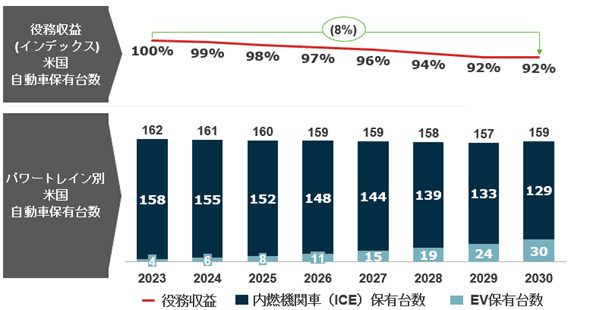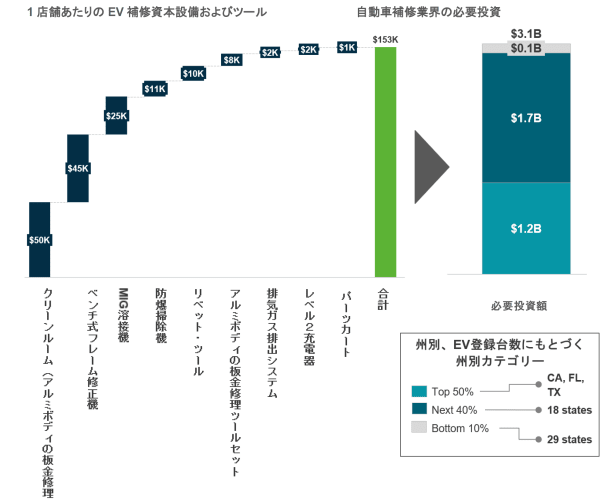アリックスパートナーズ、「EV普及とアフターサービス市場の課題に関するレポート」を発表
【2023年12月14日】グローバル・コンサルティング・ファームのアリックスパートナーズ(本社:米国ニューヨーク、日本:東京都千代田区、共同代表:野田努、植地卓郎、以下、当社)は、「電気自動車(EV)普及とアフターサービス市場の課題に関するレポート」を発表いたしました。
現在、自動車のアフターマーケット業界は、人手不足、部品調達の遅れ、修理台数の減少など、様々な課題を抱えています。短期的にみると、これらの課題が電気自動車(EV)の普及を予想以上に遅らせるとされ、長期的には、EVの普及はアフターマーケット業界の課題をより深刻化させるとみています。より少ない部品で製造されるEVは、アフターマーケット・サプライヤーへの依存度が低いため、今後、数年間でアフターマーケット市場は数十億ドルの損益に見舞われると予想されます。
アリックスパートナーズの分析では、2030年までには、EVの新車と中古車が、現在の米国における自動車保有台数(全登録台数)の約1%から約11%まで増加すると予測しています。歴史的には、自動車のアフターマーケット市場は、内燃機関車を中心に技術を進化させ、収益を上げてきましたが、米国では10年間市場に出回っている自動車(過去10年間に登録されたすべての自動車)台数のうち、2030年までにはおよそ19%がEVになるとみています。
EVにはエンジンや従来のトランスミッションがないため、オイル交換やトランスミッションの洗浄といった定期的なメンテナンス・サービスの需要が減少します。当社の予測では、EVにおいては従来の自動車に比べて1台当たりのサービス収入が40%減少することになります。結果、2030年までアフターサービス業界の年間収益は8%減少し、総額で40億~60億ドル減少すると見込まれます。(図-1)
図-1:米国のアフターサービス業界の年間収益の予測
出典:アリックスパートナーズ分析
現在、米国におけるEV修理の粗利益率は同等のICE修理の粗利益率よりも約4%ポイント低くなっています。EVは、利益率の高いアフターマーケットで取り扱う部品ではなく、利益率の低い純正交換部品を必要とする割合が高いことに起因しています。こうした利益率の低さは、修理工賃の利益では相殺することはできず、また、電子機器のキャリブレーションの増加等、EVに関連する追加的コストも押し上げ要因となっています。
米国では、アフターサービス業界においては、1店舗あたりおよそ15万ドル、業界全体では30億ドル以上の投資が必要になると予測されます。(図-2)
図-2:アフターサービス業界におけるEV移行のために必要とされる投資
費用の見積もりはすべて1台分の概算。EV修理能力の拡大には追加ユニットが必要。
出典:フェンダーベンダー、アリックスパートナーズ分析
アリックスパートナーズのマネージング・ディレクターで自動車・製造業プラクティス日本チームリーダーである鈴木智之は次のように述べています。「アフターサービス業界は、EVへの移行による収益とマージンの影響に備えなければなりません。サービスや修理事業者は、従業員のスキルアップに必要な追加投資を検証し、電気機器のキャリブレーションなどEVに必要な新たな技術を提供するためのパートナーシップの構築、さらには、収益と利益率の課題から業界再編を検討する必要もあるかもしれません。今後は自動車メーカーやサプライヤーと同様に、アフターサービス業界においても、EV移行にかかる詳細な業界分析に基づいた経営戦略および事業計画を策定することが必至です。」